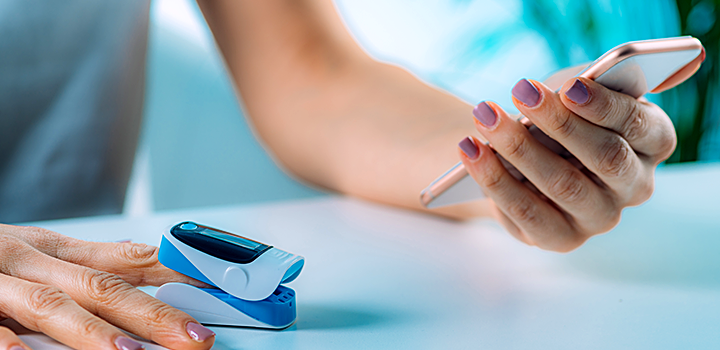COVID-19 care: How to monitor your oxygen levels with a pulse oximeter

If you've tested positive for COVID-19, using a pulse oximeter device at home can help detect oxygen-related problems, if they develop, says Vitality clinician Dr Seranne Motilal.
Monitoring oxygen levels can save lives
Emerging evidence from COVID-19 outbreaks in Europe and the United States shows that, in some cases, COVID-19 pneumonia can reduce oxygen levels in the blood.
"Healthcare professionals call this 'silent hypoxia', because you don't realise it's happening - and that's the really dangerous part," Dr Motilal explains.
"Patients with this type of pneumonia usually don't feel short of breath, even though their oxygen levels are dropping. Using a pulse oximeter device (especially five to ten days after being infected) can help detect oxygen-related problems early, so you can contact your doctor before you become critically ill," she says.
These five measures are important to monitor as they all increase the risk of developing cardiovascular disease and diabetes.
How pulse oximeters work
A pulse oximeter is a small, lightweight, device that fits over your fingertip and measures your oxygen saturation - that is, the amount of oxygen in the blood.
It can tell you immediately if your oxygen saturation has fallen below 90%. "This means you're in a danger zone and need to find medical help right away," says Dr Motilal.
Get up to 50% back on a new oximeter at Dis-Chem, with your Vitality HealthyCare benefit.
Read more about HealthyCare rewards here.
If you've tested positive for COVID-19, you should:
- Check your oxygen saturation at least three times a day (morning, afternoon, evening) for two weeks.
- Make a note of the numbers each time in case you need to discuss anything with your doctor.
What the pulse oximeter shows you - and what this means
The device shows two numbers:
This is shown as a percentage (%).
- Your pulse rate
This is your resting heart rate, measured in beats per minute. It's often shown by a heart symbol. "A rate of 60 to 100 is normal, although athletes with a higher cardiovascular fitness will have a lower pulse," says Dr Motilal. - Your oxygen saturation
This is shown as a percentage (%).
- 95% or more: Keep tracking and recording your readings.
- 90% to 94%: Call your doctor to discuss the readings.
- Below 90%: Get medical help immediately.
"Remember, though, that if you have any difficulty breathing, like shortness of breath or wheezing, if any of your symptoms get worse or if you're not coping, contact your doctor immediately - even if your readings look normal," says Dr Motilal.
Call us for support
Our dedicated oximetry call centre is open during office hours. Call us on 011 529 6113.
- Choose Option 1 for clinical support.
- Choose Option 2 for help with setting up or using your oximeter.